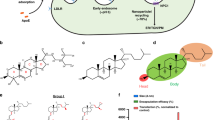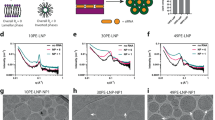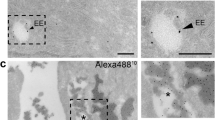Abstract
The internalization mechanisms associated with octaarginine and stearyl-octaarginine were investigated using confocal laser microscopy and flow cytometric analysis. Octaarginine is able to translocate through cell membranes in a manner that does not exactly involve the classical endocytic pathways of internalization. However, when a stearyl moiety is attached to the N-terminus of octaarginine, the internalization shifts mainly to an endocytosis-dependent pathway. The transfection efficiency of stearyl-octaarginine was significantly higher than that of octaarginin. To understand the mechanism of the improved gene transfer by the N-terminal stearylation of octaarginine, the gene transfer processes mediated by octaarginine or stearyl-octaarginine were compared. Both octaarginine and stearyl-octaarginine are able to carry plasmid DNA into cells. The amount of plasmid DNA internalized as well as that delivered to the nucleus was higher in the case of stearyl-octaarginine. Even though the internalization mechanisms of octaarginine and stearyl-octaarginine were different, their complexes with plasmid DNA were internalized via the same pathway, presumably, the clathrin-mediated pathway of endocytosis. The results of the atomic force microscopy revealed that stearyl-octaarginine, but not octaarginine, can completely condense the DNA into stable complexes that can be highly adsorbed to the cell surface and subsequently highly internalized. Therefore, using stearylated-octaarginine provided higher internalization of plasmid DNA into cells, due to enhanced cellular association, as well as higher nuclear delivery. The results presented in this study provide a better understanding of the mechanisms of improved transfection using stearylated-octaarginine. The concept of using stearylated peptides may aid in the development of more efficient nonviral gene vectors.
This is a preview of subscription content, access via your institution
Access options
Subscribe to this journal
Receive 12 print issues and online access
$259.00 per year
only $21.58 per issue
Buy this article
- Purchase on Springer Link
- Instant access to full article PDF
Prices may be subject to local taxes which are calculated during checkout









Similar content being viewed by others
References
Fawell S et al. Tat-mediated delivery of heterologous proteins into cells. Proc Natl Acad Sci USA 1994; 61: 664–668.
Frankel AD, Pabo CO . Cellular uptake of the Tat protein from human immunodeficiency virus. Cell 1988; 55: 1189–1193.
Schwarze SR, Ho A, Vocero-Akbani A, Dowdy SF . In vivo protein transduction: delivery of a biologically active protein into the mouse. Science 1999; 285: 1569–1572.
Futaki S et al. Arginine-rich peptides: an abundant source of membrane-permeable peptides having potential as carriers for intracellular protein delivery. J Biol Chem 2001; 276: 5836–5840.
Vives E, Brodin P, Lebleu B . A truncated HIV-1 Tat protein basic domain rapidly translocates through the plasma membrane and accumulates in the cell nucleus. J Biol Chem 1997; 272: 16010–16017.
Lindgren M, Hallbrink M, Prochiantz A, Langel U . Cell-penetrating peptides. TiPS 2000; 21: 99–103.
Schwarze SR, Hruska KA, Dowdy SF . Protein transduction: unrestricted delivery into all cells? Trends Cell Biol 2000; 10: 290–295.
Derossi D, Chassing G, Prochiantz A . Trojan peptides: the penetration system for intracellular delivery. Trends Cell Biol 1998; 8: 84–87.
Derossi D et al. Cell internalization of the third helix of the Antennapedia homeodomain is receptor-independent. J Biol Chem 1996; 271: 18188–18193.
Derossi D, Joliot AH, Chassing G, Prochiantz A . The third helix of the Antennapedia homeodomain translocates through biological membranes. J Biol Chem 1994; 269: 10444–10450.
Suzuki T et al. Possible existence of common internalization mechanisms among arginine-rich peptides. J Biol Chem 2002; 277: 2437–2430.
Torchilin VP, Rammohan R, Weissig V, Levechenko TS . Tat peptide on the surface of liposomes affords their efficient intracellular delivery even at low temperature and in presence of metabolic inhibitors. Proc Natl Acad Sci USA 2001; 98: 8786–8791.
Eguchi A et al. Protein transduction domain of HIV-1 Tat protein promotes efficient delivery of DNA into mammalian cells. J Biol Chem 2001; 276: 26204–26210.
Richard JP et al. Cell-penetrating peptides: a revolution of the mechanism of cellular uptake. J Biol Chem 2003; 278: 585–590.
Kramer SD, Wunderli-Allenspach H . No entry for TAT(44–57) into liposomes and intact MDCK cells: novel approach to study membrane permeation of cell-penetrating peptides. Biochim Biophys Acta 2003; 1609: 161–169.
Wender PA et al. The design, synthesis, and evaluation of molecules that enable or enhance cellular uptake: peptoid molecular transporters. Proc Natl Acad Sci USA 2000; 97: 13003–13008.
Futaki S et al. Stearylated arginine-rich peptides: a new class of transfection systems. Bioconjugate Chem 2001; 12: 1005–1011.
Andrieu N, Salvayre R, Jaffrezou JP, Levade T . Low temperature and hypertonicity do not block cytokine-induced stimulation of the sphingomyelin pathway but inhibit nuclear factor-κB activation. J Biol Chem 1995; 270: 24518–24524.
Lamaze C, Schmid SL . The emergence of clathrin-independent pinocytic pathways. Curr Opin Cell Biol 1995; 7: 573–580.
Anderson RGW . The caveolae membrane system. Annu Rev Biochem 1998; 67: 199–225.
Hansen SH, Sandvig K, Deurs BV . Clathrin and HA2 adaptors: effects of potassium depletion, hypertonic medium, and cytosol acidification. J Cell Biol 1993; 121: 61–72.
Orlandi PA, Fishman PH . Filipin-dependent inhibition of cholera toxin: evidence for toxin internalization and activation through caveolae-like domains. J Cell Biol 1998; 141: 905–915.
Schnitzer JE, Oh P, Pinney E, Allard J . Filipin-sensitive caveolae-mediated transport in endothelium: reduced transcytosis, scavenger endocytosis, and capillary permeability of select macromolecules. J Cell Biol 1994; 127: 1217–1232.
Klausner RD et al. Receptor-mediated endocytosis of Transferrin in K562 cells. J Biol Chem 1983; 258: 4715–4724.
Wong M, Kong S, Dragowska WH, Bally MB . Oxazole yellow homodimer Y0Y0-1-labeled DNA: a fluorescent complex that can be used to assess structural changes in DNA following formation and cellular delivery of cationic lipid DNA complexes. Biochim Biophys Acta 2001; 1527: 61–72.
Tyagi M, Rusnati M, Presta M, Giacca M . Internalization of HIV-1 Tat requires cell surface haparan sulfate proteoglycans. J Biol Chem 2001; 276: 3254–3261.
Acknowledgements
This work was supported in part by Grants-in-Aid for Scientific Research (B) from the Ministry of Education, Culture, Sports, Science and Technology of Japan, and by Grants-in-Aid for Scientific Research on Priority Areas from the Japan Society for the Promotion of Science.
Author information
Authors and Affiliations
Rights and permissions
About this article
Cite this article
Khalil, I., Futaki, S., Niwa, M. et al. Mechanism of improved gene transfer by the N-terminal stearylation of octaarginine: enhanced cellular association by hydrophobic core formation. Gene Ther 11, 636–644 (2004). https://doi.org/10.1038/sj.gt.3302128
Received:
Accepted:
Published:
Issue Date:
DOI: https://doi.org/10.1038/sj.gt.3302128
Keywords
This article is cited by
-
A Bio-inspired Hypoxia Sensor using HIF1a-Oxygen-Dependent Degradation Domain
Scientific Reports (2019)
-
Targeted siRNA therapy using cytoplasm-responsive nanocarriers and cell-penetrating peptides
Journal of Pharmaceutical Investigation (2014)
-
Cell-penetrating Peptides as Versatile Vehicles for Oligonucleotide Delivery
Molecular Therapy (2012)
-
MITF-siRNA Formulation Is a Safe and Effective Therapy for Human Melasma
Molecular Therapy (2011)
-
A Peptide-based Vector for Efficient Gene Transfer In Vitro and In Vivo
Molecular Therapy (2011)



